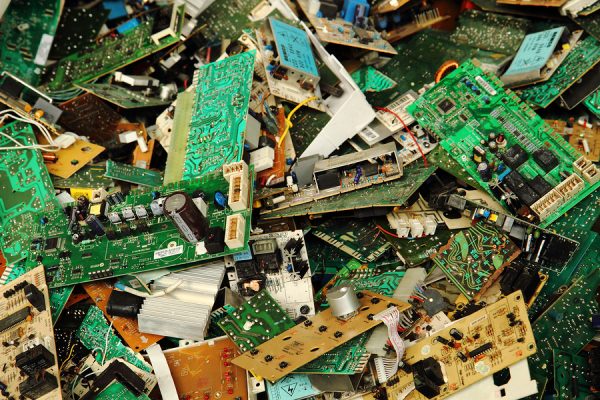
Recycling electronic devices is much harder than recycling common household materials such as paper and aluminum. Because of this, e-waste is not processed at the same facilities that process paper, plastic, aluminum, and glass. Instead, it is sent to specialized facilities that are equipped to safely and responsibly process these devices. The e-waste recycling process varies depending on the type of device. Here’s a look at how some of the most common types of e-waste are recycled:
Batteries
Batteries are sent to e-waste recycling facilities either on their own or inside electronic devices. Many states–including California–have established laws that prohibit people from throwing batteries in the trash. In these states, batteries must be disposed of properly because they are classified as hazardous waste.
The first step in the recycling process is sorting the batteries based on their type and chemistry. ERI facilities are equipped to process alkaline, lithium-ion, nickel-iron, zinc, and many other types of batteries. These batteries must be handled carefully due to the hazardous chemicals they contain.
The next steps in the recycling process will vary depending on the type and chemistry of the battery. For example, alkaline batteries, which are often used in handheld devices at home, are separated into three end products. These three end products, which include zinc and manganese concentrate, steel, and plastic, are then resold to manufacturers.
Smartphones
Once smartphones arrive at a recycling facility, they are tested to determine if they are still functional. The smartphones that are still functional are refurbished and sold. But first, the data stored on these devices must be destroyed to protect the original owners.
If a smartphone is not functional, it is sent to the powerful electronic shredder machine. The devices are broken down into small pieces, which makes sorting through the components much more manageable. Workers at the recycling facility typically sort through the components by hand and separate plastics, glass, and valuable precious metals. Smartphones contain many valuable metals, including silver, gold, palladium, copper, and platinum. These metals can easily be resold, which is why it is so important to carefully separate them from the rest of the lower value materials.
Laptops
Laptop computers are also frequently sent to e-waste recycling facilities. These complex devices must be broken down as soon as they arrive at the facility. The exact construction of a laptop depends on the manufacturer and design. But in general, laptops are broken down to separate the battery, plastic frame, hard drive, motherboard, memory, and lightbulbs.
The memory and hard drive are completely wiped to ensure the data that these components contain is destroyed. The plastic frame of the laptop is sent to the electronic shredder, where it is crushed into smaller pieces of recyclable plastics.
Similar to smartphones, laptops also contain valuable precious metals that are removed from the main device and resold to manufacturers. The bulbs contain small amounts of mercury, which is a hazardous material that can cause health problems and harm the environment. This part of the laptop must be handled with extreme care to ensure the mercury is disposed of in a responsible manner. But fortunately, almost every part of the bulbs used in laptops, including the mercury, can be resold and reused as long as they are intact.
Recycling a laptop is not easy because each device is made with so many different materials. But, a trusted e-waste recycler like ERI can process thousands of laptops in a safe and responsible manner.
Keyboards
Keyboards are typically sent to e-waste recycling facilities whenever someone disposes of a desktop computer. Keyboards are low-value products that are usually not resold to manufacturers. Instead, these devices are sent to the shredder so they can be broken down into smaller pieces. The shredder machine crushes keyboards into small pieces so a team of workers can manually sort through what remains to remove valuable plastics and precious metals. Although the fully intact keyboard has a low resale value, these raw materials are still in high demand, so they are resold to manufacturers.
Mice
Most recycling facilities receive a large volume of mice every year. This is mainly because these accessories are not very durable, so they are replaced often. A mouse is a simple device compared to other complex electronics, but it still contains a handful of valuable materials that can be resold to manufacturers. Before the materials are extracted, the mouse is broken down in the shredder. Then, the workers at the facility manually extract materials of value.
Printers
Printers are designed with lamps that contain small amounts of mercury, so these must be removed as soon as printers arrive at a recycling facility. After the lamps are removed, the rest of the printer is sent through the shredder so it can be broken down into smaller pieces. A team will then sort through the shredded remains to pull out steel, glass, copper, and other materials that can be resold.
If the printer has ink cartridges inside it, these must be processed separately from the rest of the device. Sometimes, the cartridges are refilled with ink and resold, but this is only an option if they are still in good condition. If not, the facility can separate the plastic from the other materials used to create the cartridge and resell everything of value.
These are just some of the many devices that are processed within our facilities. ERI is the largest electronic waste recycler in the U.S., responsible for recycling over 250 million pounds of electronic waste every year. All of ERI’s facilities have received R2 and e-Stewards certification, the two most prestigious certifications with the e-waste industry. For more information on recycling electronics, or to request a quote, contact us today.